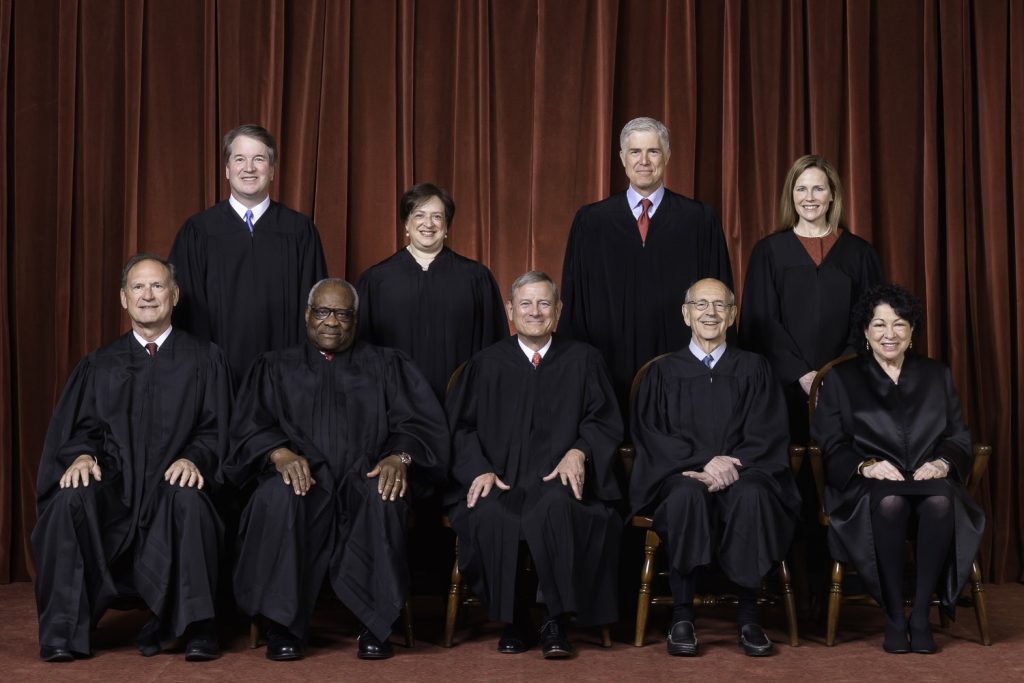WASHINGTON, D.C, May 11, 2022 – On May 2, Politico broke the news that the Supreme Court is poised to overturn Roe v. Wade per a leaked draft of the majority opinion, which was penned by Justice Samuel Alito and obtained by Politico.
The U.S. Senate is expected to vote Wednesday on the Women’s Health Protection Act, a Democrat-led bill to codify a right to an abortion. However, it appears that Democrats do not have enough support from Republicans to reach the 60-vote threshold to end a filibuster. Senator Joe Manchin (D-West Virginia) announced that he will not be supporting his party’s bill.
“Washington state voters don’t have to guess with me, they know I will fight with everything I have to protect a woman’s right to abortion,” Senator Patty Murray (D-Washington) wrote in a statement to the Lynnwood Times.
I have always supported the right to abortion. I have always fought back at Republican attempts to undermine Roe v. Wade. The stakes may be higher now, but my commitment to protecting this fundamental right has never wavered. pic.twitter.com/cGLqhgMqk2
— Senator Patty Murray (@PattyMurray) May 11, 2022
“The vast majority of Americans support a women’s right to make her own health care decisions, especially here in Washington state where abortion was made legal even before Roe v. Wade. It is stunning and appalling to me that for the first time in decades, mothers in this country will have had more rights than their daughters—but it is not surprising, this has been the ultimate goal of an increasingly extreme and far-right Republican Party.”
The U.S. Senate is split 50-50 and would require Vice President Kamala Harris to break a tie vote. Both Democrats and progressives have urged the party to seek to scrap the filibuster, the Senate rule that requires 60 votes for most legislation.
“If the leaked opinion became the final opinion, legislative bodies – not only at the state level but at the federal level – certainly could legislate in that area,” Senate Minority Leader Mitch McConnell (R-Kentucky) told USA Today over the weekend, hinting that a nationwide ban on abortion is possible. However, on Tuesday, he told reporters that most of his caucus believes abortion laws should be left to each state.
.@LeaderMcConnell on abortion: "There are no issues which Senate Republicans believe should be exempt from the 60-vote threshold…This issue will be dealt with at the state level." pic.twitter.com/4K6W8cLDyL
— CSPAN (@cspan) May 10, 2022
As of the time of the publishing of this article, the Supreme Court’s minority opinion has not been leaked to the public.
Roe v. Wade, Mississippi, and the leaked draft opinion
In the draft opinion to overturn Roe v. Wade, Justice Alito seemingly sidesteps the pro-life v. pro-choice debate altogether, opting instead to challenge the constitutionality of the landmark decision of 1973 that legalized abortions across the U.S.
In Roe v. Wade’s decision, the Supreme Court determined that the right to an abortion was implicitly protected by the 14th Amendment, which guarantees a citizen’s right to privacy. The 1973 decision reads, “This right of privacy, […] in the Fourteenth Amendment’s concept of personal liberty and restrictions upon state action […] is broad enough to encompass a woman’s decision whether or not to terminate her pregnancy.”
Upon the 1973 ruling, women could decide to terminate a pregnancy in the first trimester (0-13 weeks) of their own accord. Abortions during the second trimester (14-26 weeks) could be regulated by the government but not banned altogether. By the third trimester (27-40 weeks), states could prohibit aborting a fetus that could survive outside of the womb unless the woman’s health was threatened.
Almost 50 years later, the Supreme Court began deliberating abortion anew in May after agreeing to review the heated debates surrounding a Mississippi law that bans most abortions after 15 weeks, roughly two months earlier than Roe v. Wade’s decision allows.
Justice Alito’s fundamental take on the matter reverts the power to confer abortion rights back to the states. “It is time to heed the Constitution and return the issue of abortion to the people’s elected representatives,” he wrote in the 98-page Supreme Court opinion that leaked on Monday.
Alito’s flagrant rebuke of Roe v. Wade refers to the 1973 ruling as an “abuse of judicial authority” and argues against its assertion that the Constitution “confers a broad right to obtain [an abortion].”
“The Constitution makes no reference to abortion, and no such right is implicitly protected by any constitutional provision,” Alito writes.
The 2022 opinion further argues that the right to abortion doesn’t constitute common law as it is not deeply rooted in the country’s history. “Until the latter part of the 20th century,” states the opinion, “there was no support in American law for a constitutional right to obtain an abortion. Zero. None. No state constitutional provision had recognized such a right.”
In fact, Alito states that the US has “an unbroken tradition of prohibiting abortion on pain of criminal punishment […] from the earliest days of the common law until 1973.”
Ultimately, Alito concludes that decentralizing the Federal government’s power to enact abortion rights and redistributing said power to the states “is what the constitution and rule of law demand.”
Republican-appointed Justices Clarence Thomas, Niel Gorsuch, Brett Kavanaugh, and Amy Coney Barrett voted with Alito, making their opinion the majority. On the dissenting side are Democratic-appointed Justices Stephen Breyer, Sonia Sotomayor, and Elena Kegan. Which way Chief Justice John Roberts will vote remains unclear, Politico reports.
It should be noted that the leaked draft merely represents the current opinion of the majority, which is subject to change. As Politico reports, “The court’s holding will not be final until it is published, likely in the next two months.”
My state, my choice
An abortion proceedure may soon depend wholly on the state in which one resides, and each state is already looking to enact different regulations. Thirteen states, including Idaho, Texas, and Utah, have previously passed “trigger laws” which would automatically restrict or ban abortions upon the Supreme Court’s ruling.
While states like Oklahoma have just recently enacted abortion trigger laws, others have had them in place for more than a decade. South Dakota, for example, has had its trigger law ready to go since 2005, which would make abortions illegal in all cases except for when the mother’s life is threatened.
On the flip side, 16 states have already codified abortion policy into law, including California, Vermont, Nevada, Oregon, and Washington. Of these 16 states, 12 of them explicitly permit abortion when necessary to protect a woman’s life and before fetus viability, while the other 4 protect the right to abortion without state interference.
Overall in the United States, the law in a vast majority of states permit the termination of a pregnancy no later than the end of the second trimester (14-26 weeks) with 20 or 24 weeks being the preferred limit with exceptions. However, in Mexico, Canada and in European countries, the gestational limits are much less.
Last year, Mexico’s Supreme Court unanimously ruled in September to decriminalize abortion. The procedure is allowed until up to the 12th week of pregnancy (first trimester).
Currently, there are no Canadian laws that explicitly guarantee access to abortion after is was decriminalized in Canada in 1988 when the Supreme Court of Canada struck down a federal law. Across Canadian provinces, abortions are regulated similarly to other health-care procedures and according to a study published by Action Canada for Sexual Health and Rights in 2019, no providers in Canada offer abortion services after 23 weeks and six days of pregnancy.
Six European countries retain highly restrictive abortion laws and do not permit abortion on request or on broad social grounds – Andorra, Liechtenstein, Malta, Monaco, Poland and San Marino.
While the remaining European countries allow abortions, the most common gestational limit is 12 to 15 weeks (no later than two weeks into the second trimester) with exceptions to the end of the second trimester. Turkey allows for abortions up to 10 weeks and Italy is 90 days with an exception up to 13 weeks. The European countries with the latest gestational limits are Sweden (18 weeks with an expectation up to 22 weeks), Netherlands (24 weeks), and Ireland (22 weeks).
How Americans feel about abortion
According to the most recent data from Gallup, 48% of Americans believe abortion should be legal “under certain circumstances,” while 32% believe abortion should be legal “under any circumstances,” and only 19% believe it should be illegal “in all circumstances.”
Though Gallup’s poll indicates a lack of consensus on the issue, Pew Research’s simplified poll, which only gives surveyees two options to choose from, suggests that the majority of Americans fall under the pro-choice category. In Spring 2021, Pew found that “Around six-in-ten U.S. adults (59%) say that abortion should be legal in all or most cases; 39% say it should be illegal in all or most cases.”
Likely to no one’s surprise, the political divide in the debate has increased in recent years. According to Pew Research, “Democrats and Democratic-leaning independents are much more likely than Republicans and Republican leaners to say abortion should be legal in all or most cases today (80% vs. 35%).” The 45 percentage point gap is up by 12-points compared to 2016’s numbers “when 72% of Democrats and 39% of Republicans supported legal abortion in all or most cases.”
Furthermore, as abortion is a key issue every election cycle, it’s hardly a passive subject in the nation’s collective mind. As Gallup reported in 2020, one in four Americans consider abortion to be a key issue, and when examining the pro-life and pro-choice arguments, it’s not hard to see why.
Inherent in the name, the pro-life argument revolves around life and its intrinsic value, as the non-profit organization Family Policy Institute of Washington asserts in its statement on the subject:
“We believe life is sacred and should be protected at every stage and at every opportunity. We agree with the science that overwhelmingly confirms that life begins from the moment of conception or fertilization and continues to the moment of natural death, and that human life is intrinsically and eternally significant.”
On the pro-choice side, again, as indicated by the name, the argument centers on bodily autonomy and women’s freedom to choose, as the non-profit organization NARAL Pro-Choice America explains in its statement on the issue:
“The right to choose abortion is essential to ensuring a woman can decide for herself if, when and with whom to start or grow a family. […] When the right to abortion is endangered, the fundamental equality of women is threatened. A woman can never be equal if she is denied the basic right to make decisions for herself and her family.”
Finding the leaker
Another newsworthy aspect of this story is the leak itself. As of now, it is unknown who leaked the draft opinion. When Politico broke the news at the beginning of the month, it simply stated that the draft “circulated inside the court and [was] obtained by POLITICO,” and that the publication got the documents “from a person familiar with the court’s proceedings,” though it’s unclear whether they were electronic or physical copies.
Though the description of the leaker is somewhat vague, it’s plausible that it was one of the justice’s clerks. As there are four clerks to each of the nine justices, there’s still a pool of 36 potential leakers.
However, given Attorney General Merrick B. Garland’s somewhat recent announcement, the leaker’s identity could remain hidden for quite some time. In a policy memo to federal prosecutors dated July 2021, Garland issued a prohibition against subpoenas, warrants or court orders to seize journalists’ communications in an effort to reveal anonymous sources.
“The Department of Justice will no longer use compulsory legal process for the purpose of obtaining information from or records of members of the news media acting within the scope of newsgathering activities,” Garland writes before laying out what the scope entails.
Garland makes exceptions for information obtained through criminal activity. He also states that the prohibition does not “affect the Department’s traditional ability to use compulsory legal process to obtain information from or records of, for example, a government employee (rather than a member of the news media) who has unlawfully disclosed government information.”
It seems then that the Politico journalists who published the draft opinion, Josh Gerstein and Alexander Ward, are off the hook, but if the leaker is a government employee, say a clerk, their communications records could still be seized by the court.
A history of leaks
This month’s leak is not the first time in U.S. history that the Supreme Court’s inner deliberations have been shared with the public before official publication. Coincidentally, a similar situation occurred in 1972 when the Washington Post published a piece that featured a leaked memo from Justice William O. Douglas to his fellow justices regarding Roe v. Wade.
Then, in 1973, TIME published the original Roe v. Wade decision only hours before the court was set to announce it. NPR reports that then-Chief Justice Warren Burger was enraged over the leak and demanded the culprit be identified and punished.
However, the leaker turned out to be a Supreme Court clerk named Larry Hammond, who immediately came clean, claimed to have been double-crossed, and offered to resign. While Burger was slow to forgive TIME, he ultimately accepted Hammond’s apology and allowed him to keep his job.
In this most recent case of a Supreme Court leak, Chief Justice John G. Roberts is outwardly perturbed. In a press release published one day after Politico’s report, the Chief Justice called the move a “betrayal of the confidences of the Court” that was “intended to undermine the integrity of our operations.”
“Court employees have an exemplary and important tradition of respecting the confidentiality of the judicial process and upholding the trust of the Court,” Roberts continued. “This was a singular and egregious breach of that trust that is an affront to the Court and the community of public servants who work here.”
Roberts ended his statement by announcing that he has tasked the Marshal of the Court to investigate the source of the leak, though it’s difficult to say what consequences the leaker might face.
As the New York Times reports, the First Amendment protects “the publication of a leak, but not the leaker.” This fact was made clear back in 1971 when Daniel Ellsberg leaked the Pentagon Papers, a classified account of U.S. intel on the Vietnam War. Legacy news outlets like the New York Times, the Washington Post, and the Boston Globe all published sections of the documents.
When the U.S. Government filed suit against the New York Times that same year, the Supreme Court ruled that the government could not prevent the news outlet from publishing the leaked classified documents.
However, Daniel Ellsburg did not get off so easily. Ellsburg was accused of theft of government property and unauthorized possession of national defense documents by a Federal Grand Jury and faced a 115-year-long prison sentence. The charges would be dropped due to “improper government conduct.” Ellsburg essentially was let off the hook only because the Court found the government was more at fault than the leaker of classified documents.
Consequences of confidentiality breach
Of course, this current case is different because the Court’s draft opinion isn’t considered a classified document, so the leaking thereof is not illegal, though legal experts told the New York Times that a “criminal investigation is not unthinkable.”
However, as Roberts mentioned in his press release, the Supreme Court does hold an “important tradition of respecting […] confidentiality.”
Multiple reports have suggested that the leaker responsible for violating said confidentiality will likely see the death of their career. One report even quotes former Supreme Court Justice Antonin Scalia as having told his newly hired clerks, “If I ever discover that you have betrayed the confidences of what goes on in these chambers, I will do everything in my power to ruin your career.”
Confidentiality has been historically sacrosanct among Supreme Court officials. In 1955, Justice Felix Frankfurter suggested that the Court’s commitment to confidentiality not only separated it from the other two branches of government but was even the key to its success. “That the Supreme Court should not be amenable to the forces of publicity to which the Executive and the Congress are subjected is essential to the effective functioning of the Court,” he said.
In his opinion piece for NBC News, assistant professor of law at Boston College Law School Ryan C. Williams argues that the leak will have immediate and prolonged consequences. After explaining how suspicions have likely arisen between partisan justices thanks to the leak, Williams claims the breach of confidentiality will “seriously impede justices and their respective staffs from working effectively with one another.”
As for the long-term consequences, Williams says the effectiveness of the court could be hindered if justices have to fear further leaks. “The exchange of interim drafts helps justices negotiate over the content of an eventual majority opinion and allows the authoring justice to respond to concerns of the other justices in the majority,” he explains.
“This process cannot function effectively if the justices are unwilling to share their candid views with one another due to fears about potential leaks.”
As for how Justice Roberts feels about the leak, in his previously mentioned statement, he assured the public that “The work of the Court will not be affected in any way.”
Potential intimidation and protests
Some outlets, like the Heritage Foundation, also claim the leak was an attempt to intimidate or bully justices into changing their votes, though it’s unclear whether or not leaking the draft opinion constitutes intimidation.
The same can’t be said for pro-choice protestors who have gathered at the homes of Justices John Roberts Jr., Brett Kavanaugh, Clarence Thomas, Amy Coney Barrett, Neil Gorsuch, and Chief Justice Samuel Alito following Politico’s report.
During a primetime show on Fox News, Former US Attorney General Bill Barr said of the demonstrators, “There’s a time and place for protest. And the federal statute makes it clear that if you go to the house of a judge, the residence of a judge, to influence the judge in his decisions and demonstrate that that’s a federal crime.”
The federal statute Barr may have been referring to is 18 U.S. Code 1503, which states that anyone who “endeavors to influence or intimidate, or impede any grand or petit juror, or officer in or of any court of the United States” could face a fine or imprisonment.
However, the White House has not recognized these protests as forms of intimidation. When asked about the issue during a brief on May 9, White House Secretary Jen Psaki said, “Yes, we are a country that promotes democracy, and we certainly allow for peaceful protests in a range of places in the country. None of it should violate the law. No one is suggesting that, and it should never resort to violence, to threats, to intimidation in any way, shape or form. But that is what our position is, and the President’s position is.”





















One Response